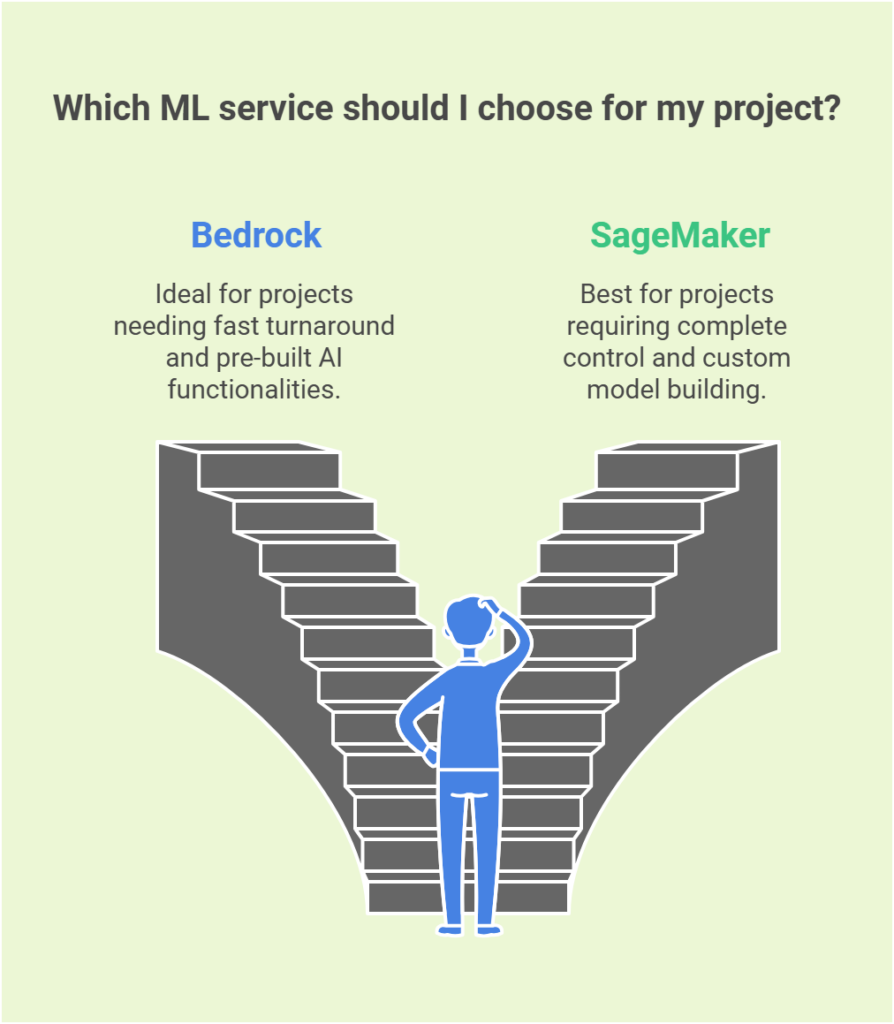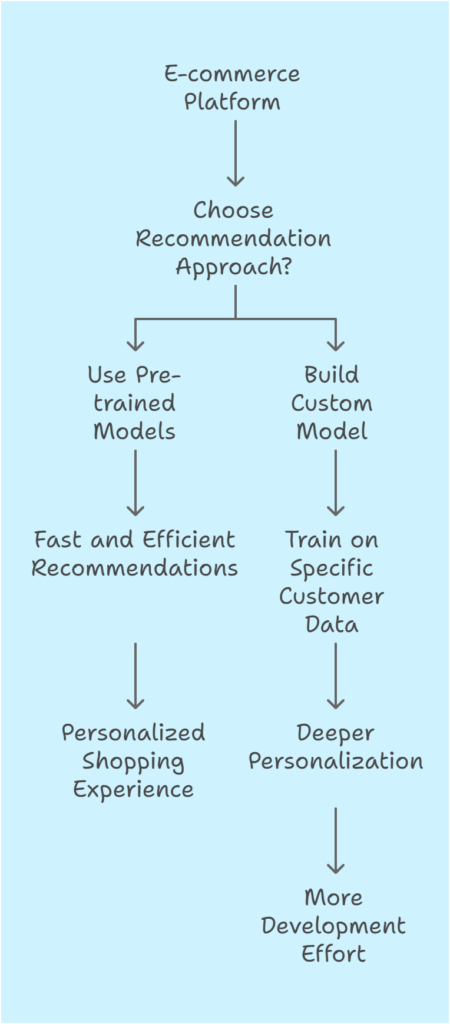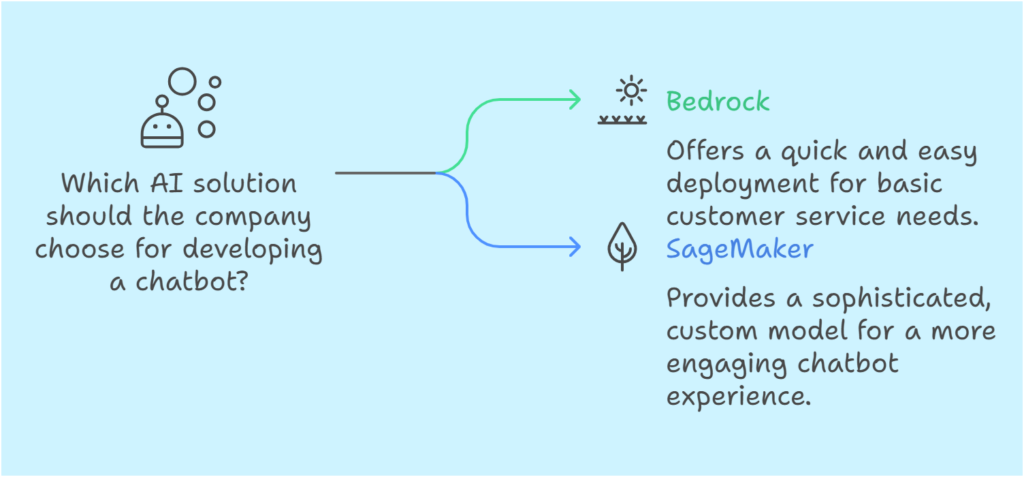In the ever-evolving world of technology, Artificial Intelligence (AI) and Machine Learning (ML) are rapidly transforming how businesses operate. For those looking to leverage these powerful tools, Amazon Web Services (AWS) offers two prominent services: Bedrock vs SageMaker. But which one is right for your project? This blog dives into a head-to-head showdown between Bedrock and SageMaker, unpacking their functionalities, highlighting their strengths and weaknesses, and showcasing real-world use cases to help you choose the champion for your ML needs.
Bedrock vs SageMaker
Understanding Bedrock and SageMaker
Both Bedrock and SageMaker empower businesses to harness the power of ML, but they cater to different development styles:
- Bedrock: Imagine a user-friendly, pre-built toolbox stocked with powerful AI components. Bedrock offers a collection of foundation models (FMs) – essentially pre-trained AI models – that can be integrated into your applications through a simple API. This fast and convenient approach is ideal for projects requiring rapid implementation of features like creative content generation, text summarization, or image recognition.
- SageMaker: Think of a comprehensive machine learning workbench. SageMaker provides a complete suite of tools encompassing the entire ML lifecycle – from data preparation and training to model deployment and management. This highly customizable platform gives you granular control over the ML process, allowing you to build and fine-tune models specific to your unique needs.
Choosing Your ML Champion: Real-World Use Cases
Now, let’s see Bedrock and SageMaker in action through real-world scenarios:
Scenario 1: E-commerce Product Personalization
- Bedrock: An e-commerce platform can leverage Bedrock’s pre-trained recommendation models to suggest relevant products to customers based on their browsing history. This fast and efficient approach personalizes the shopping experience without extensive customization.
- SageMaker: For a more fine-grained approach, SageMaker allows the e-commerce platform to build a custom recommendation model trained on their specific customer data and purchase behavior. This offers deeper personalization but requires more development effort.
Scenario 2: Building a Chatbot
- Bedrock: A company can integrate Bedrock’s pre-built chatbot models for basic customer service interactions. This quick and easy solution allows for rapid deployment of a functional chatbot.
- SageMaker: For a more sophisticated chatbot, SageMaker empowers the company to build a custom model trained on their specific customer support data and language. This leads to a more intelligent and engaging chatbot experience but requires significant development resources.
Head-to-Head Summary : Key Differences Between Bedrock and SageMaker
| Feature | Bedrock | SageMaker |
| Focus | Pre-built foundation models (FMs) | Customizable ML development platform |
| Ease of Use | Simple API integration | Requires technical expertise |
| Customization | Limited customization | Highly customizable |
| Development Time | Faster development time | Slower development time |
| Cost | Typically charged per API call | Varies based on resource usage |
| Ideal for |
* Quick implementation
* Basic AI features
* Limited data
* Simple use cases
|
* Complex projects
* Unique needs
* Large datasets
* Advanced use cases
|
| Data Management | Managed by AWS service | Requires user configuration |
| Model Explainability | Limited explainability for pre-built models | Offers greater explainability for custom models |
| Scalability | Scales automatically based on usage | Requires manual scaling for custom models |
Additional Notes:
- Data Management: Bedrock simplifies data management by handling it internally. For SageMaker, you’ll need to configure your data storage and access within the platform.
- Model Explainability: While Bedrock’s pre-built models offer limited insights into their decision-making process, SageMaker allows you to delve deeper and understand how your custom models arrive at their predictions.
- Scalability: Both services are scalable, but Bedrock’s automatic scaling based on usage offers a more hands-off approach compared to SageMaker’s manual scaling for custom models.
Conclusion
The battle between Bedrock vs SageMaker is not about which one is better, but rather which one is better suited for your specific project. For projects requiring fast turnaround and pre-built AI functionalities, Bedrock emerges as a clear winner. However, for those seeking complete control and the ability to build custom models, SageMaker reigns supreme.
By understanding the strengths and weaknesses of each service, along with the real-world use cases, you’ll be well-equipped to choose the right ML champion to propel your project forward.
FAQ’s:
Q: Is Bedrock or SageMaker more expensive?
A: The pricing structure differs between Bedrock and SageMaker. Bedrock typically charges per API call, while SageMaker has various pricing models depending on resource usage.
Q: Is there any security difference between Bedrock and SageMaker?
A: Both Bedrock and SageMaker prioritize security. AWS utilizes industry-standard security practices to safeguard your data and models. However, with SageMaker’s greater control over the ML lifecycle, you have more responsibility for implementing specific security measures within your custom models.
Q: Do I need a large team of data scientists to use either Bedrock or SageMaker?
A: The answer depends on your chosen service and project complexity. Bedrock’s user-friendly interface makes it accessible to users with some programming experience. For projects requiring extensive customization and model building within SageMaker, data science expertise might be necessary.
Q: Are there any resources available to learn more about Bedrock and SageMaker?
A: Absolutely! AWS offers comprehensive documentation and tutorials for both Bedrock and SageMaker. Here are a few helpful links to get you started:
- Bedrock Documentation: [Bedrock documentation]
- SageMaker Documentation: [AWS SageMaker documentation]
- AWS Machine Learning Resources: [AWS Machine Learning resources page]
By leveraging these resources and understanding the strengths and limitations of Bedrock and SageMaker, you can embark on your Machine Learning journey with confidence!
See also:
The Rise of the Machines: How AI is Transforming System Administration
COMPARE between S3 vs RDS vs DynamoDB vs SimpleDB





